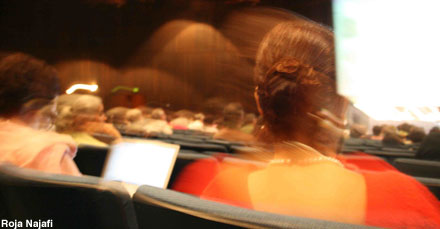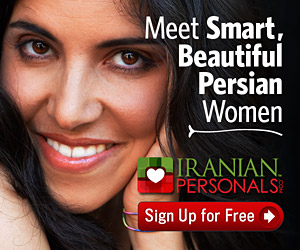
The 19th annual IWSF Conference was held from July 4th to 6th in University of California at Berkeley. Each day I attended the conference form 9 a.m. to 8 p.m., listening to more than 18 talks where the speakers, in panel discussions and in individual talks, in one way or another and based on their subject of studies and activities, tried to address the notion that was emphasized by the title of the 19the IWSF Conference: The Essential Needs of the Iranian Women Today.
Today and about three weeks after the conference, I am sitting here going through my notes and reading some reports of the conference, thinking something is missing. I see an empty space for a critical review of this lively and interactive conference, the 19th IWSF conference; a review which doesn’t lack the essence of critical thinking: a review that not only praises the strengths of this conference but also points out the ways to improve weaknesses for the future conferences.
Before I start, it is crucial to note that I am neither a journalist nor a women’s studies specialist; to the 19th IWSF conference I was merely a member of the audience. However, as a member of the audience, I was not drained of my previous education, studies and personal beliefs and biases. Throughout this review I will try to present my critical analysis free of my personal biases.
Please allow me to jump over the conference’s daily schedule and get to the main points – since it is easy to find the schedule on IWSF websites. Also the Farsi report of Radio Zamaneh by Leva Zand presents a more detailed report of the schedule. [* See the endnotes for more links and articles about the 19th IWSF conference.]
In this article I address two issues belonging to two different categories: One is the Publicity Issue, which is a practical matter and part of the general category of organizing strategies, which I hope for my suggestions to be considered in the organizers’ long time strategies; and the other issue is the rule of IWSF as a bridge between academia and real world.
Publicity Issues: The More, the Merrier; the More, the Wealthier
Besides the fact that the more the merrier, consider the fact that a larger audience can help to cover the natural expenses of IWSF conferences.
Where cost matters publicity matters. Of course IWSF has always advertised for its annual conferences but I believe they should broaden their target audience. IWSF mostly publicizes for its events by means of Iranian communities outside of Iran, which is fine but truly not adequate, especially when they carry and use the word “International” on the title of the conference, which suggests that this is an international conference.
What does international mean? Some obvious, nonetheless correct answers can be given here such as: First, the conference is held outside of Iran; second, the talks presented are bilingual; at least two foreign speakers are invited each year, as well as many Iranian researchers who give their talks in English; and third, The IWSF audiences are comprised of different groups of people: Iranians, non-Iranians as well as the second and third generation Iranians– these make any conference an international one. The question is to what degree? The number of non Iranian, international or foreign listeners is a factor in calling a conference “International.” It is understandable for the number of non-Iranians attending an Iranian women’s studies conference to be lower than the number of Iranians in attendance. But how much lower is adequate?
My observations throughout the 19th international IWSF conference indicated that on average, there were about 5-7 people using the translation headsets for each talk, which is quite a few. I wonder whether the outreach to non-Iranian targets was inadequate, or there just isn’t a large body of interest in the conference among non-Iranians. Considering the attention Iranian women’s issues continually receive through media coverage, sale of books published on these subjects and by female Iranian authors, and high attendance rates by non-Iranians at public speeches by female Iranian authors and activists, I doubt there is a shortage of interest on the subject.
Believing that a larger audience brings more good to IWSF Conference at all levels, I think targeting universities – their Women’s studies and Middle Eastern studies departments in Europe and in United States – can attract a more international audience. This new body of international audience can also help with the cost issues: where some of the Iranian audiences think the IWSF’s registration fee is high, I guess a good number of non-Iranians (scholars and students) affiliated with academia can be reimbursed by their own universities and this can help a great deal. Being a member of College Art Association (CAA), which has an annual fee as well as a conference registration fee of $280, I personally don’t think that the IWSF registration fee is unreasonable.
To sum up this part, I formulate it in this manner: in addition to targeting and advertising in Iranian communities, let’s publicize and advertise for the IWSF conferences within the American and European academic and research institutions, and make IWSF an actively international bridge between Iranian women’s studies and other women’s studies entities.
IWSF: Academia and Activists
A quick observation shows that IWSF conferences has often presented, or attempted to present the two sides of Iranian women’s movement, the academics’ side and the activists’ side. Going through the 19th IWSF conference and also by browsing the publications of the previous IWSF conferences, (the 18th, 16th and 9th conference) it is easy to note that the articles, talks and speeches given in most of IWSF conferences are a mixture of academic talks, papers and researches and the women’s rights activists talks, reports and manifests. The attempt to present and bring together the two major sides of the subject (Iranian women) has had its positive aspects and it has also raised some concerns for IWSF.
Positive Ends
1- By bringing together the two sides at the table, IWSF has made a bridge over an always-existing gap between theoretical studies and real/practical activism in women’s studies – the gap that exists in most branches of humanities and social sciences. More than building a bridge, in some cases and to some degree, IWSF has filled this gap and has formed a common vocabulary between the two sides. As an example of this common vocabulary, I name the Women’s Movement Panel Discussion: Various Tendencies Within the Iranian Women’s Movement, where women’s rights activists used academic methods to present their talks instead of ideological manifestations, which also suited the content of their talks “Iranian women’s movement chooses Pragmatism over Idealism.” In this panel the talks were given by M. Shojaie (Feminist School) and S. Vahdatibana (Stop Stoning Forever Campaign). [Please Note that: R. Raji was also part of this panel (via phone), but her talk fell into categorizing the women’s rights activists within Iran and she emphasized that she is speaking independent of these sites and campaigns, and since hers was more of an analysis, I am counting her talk as more of a sociology researcher’s talk rather that one of an activist’s.]
2- This unification of academic theories and activism also helps with the comprehension of non-expert listeners; the 19th IWSF Conference accommodated a very wide range of audiences, surprisingly in all of the given talks and panels, especially on the second day of the conference. (Saturday July 5th 2008) [Of course for the art performances this variety was expected]. Here I like to emphasize on the fact that in general and especially in humanities and social sciences, the academic talks are theoretical and specialized on details, thus they become more abstract and harder to grasp for general public. Bringing an abstract theory closer to the reality and making it more understandable for everyone is what has unintentionally or intentionally happened in the IWSF conferences – especially in the 19th conference, which I highly praise.
Alarming
I also have some concerns about the bridge that IWSF has so successfully built between the academic world and that of women’s rights activists in Iran. These are the concerns of a yet-to-be or may-she-never-be scholar!
A seminar talk or a conference talk is supposed to be exact and accurate no matter whose talk it is, whether it is a scholar’s talk on women’s issues or a women’s rights activist’s talk on Iranian women’s movement. A conference talk is supposed to remain exact and accurate on its regarded subject matter, especially when a conference belongs to a “studies” foundation on that subject; the word “studies” holds us all responsible for the accuracy of that notion. In IWSF Conferences the unification of academic/activism can cause some accuracy problems for both sides of the stream: making scholars give emotionally charged manifestations instead of their research results and giving more weight to the popularity of a talk given by an activist versus its accuracy.
As a former Cinema student, I have often heard a sentence that I think is good to mention here: a good film is usually loved by the general public, BUT not every film that is loved by the general public is a good film. There were examples of these inaccurate talks in the 19th IWSF Conference, which here I excuse myself from naming, so that I can give more weight to the many good talks presented in the 19th IWSF conference. IWSF is a bridge beautifully built which stands on strong foundations and I earnestly do not like to see any fog over this bridge; a fog built with inexact speeches – for no matter how romantic a fog is, it may cause us to forget where to put our next steps. Please keep in mind that this is only a concern for the future IWSF conferences, an alarm that was needed to be raised.
My thanks go to Nazy Kaviani for her careful editing and insightful comments.
To read more about the Iranian Women’s Studies Foundation and the 19th international IWSF conference please check:
Also here are the links to three articles (report and review) in Farsi regarding the same conference:
* Bandari, Roja, The review of the 19th IWSF conference at WE Change. Org
*
*






